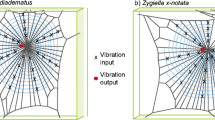Abstract
Most of the spiders can hunt a prey and avoid the threat of predators by sensing web vibration. Spiders have eight legs, and it has the sense organs to detect vibrations. These vibration sensing organs can be observed at the slit sensilla on each leg. A distribution of the web string tension effectivelytransfer the vibration of a spider web into another place. In order to investigate the characteristics of the spider web, we test various sensors in the artificial web. We apply a population coding approach to detect the orientation of the web vibration source. We demonstrate the result in the vibration experiments.
Access this chapter
Tax calculation will be finalised at checkout
Purchases are for personal use only
Preview
Unable to display preview. Download preview PDF.
Similar content being viewed by others
References
Barth, F.G., Seyfarth, E.: Slit sense organs and kinesthetic orientation. Zeitschrift Fr Vergleichende Physiologie 74, 326–328 (1971)
Seyfarth, E., Barth, F.G.: Compound slit sense organs on the spider leg: Mechanoreceptors involved in kinesthetic orientation. Journal of Comparative Physiology 78, 176–191 (1972)
Seyfarth, E.: Lyriform slit sense organs and muscle reflexes in the spider leg. Journal of Comparative Physiology 125, 45–57 (1978)
Seyfarth, E., Pflger, H.: Proprioceptor distribution and control of a muscle reflex in the tibia of spider legs. Journal of Neurobiology 15, 365–374 (1984)
Barth, F.G.: Spider vibration receptors: Threshold curves of individual slits in the metatarsal lyriform organ. Journal of Comparative Physiology 148, 175–185 (1982)
Hergenrder, R., Barth, F.G.: The release of attack and escape behavior by vibratory stimuli in a wandering spider (Cupiennim salei keys). Journal of Comparative Physiology 152, 347–359 (1983)
Gingl, E., Burger, A., Barth, F.G.: Intracellular recording from a spider vibration receptor. Journal of Comparative Physiology A 192, 551–558 (2006)
Molina, J., Schaber, C.F., Barth, F.G.: In search of differences between the two types of sensory cells innervating spider slit sensilla (Cupiennius salei Keys). Journal of Comparative Physiology A 195, 1031–1041 (2009)
Schaber, C.F., Gorb, S.N., Barth, F.G.: Force transformation in spider strain sensors: White light interferometry. Journal of the Royal Society Interface 9, 1254–1264 (2012)
Masters, W.M., Markl, H.: Vibration signal transmission in spider orb webs. Science 213, 363–365 (1981)
Landolfa, M.A., Barth, F.G.: Vibrations in the orb web of the spider Nephila clavipes: Cues for discrimination and orientation. Journal of Comparative Physiology A 179, 493–508 (1996)
Brownell, P.H., van Hemmen, J.L.: Vibration sensitivity and a computational theory for prey-localizing behavior in sand scorpions. American Zoologist 41, 1229–1240 (2001)
Author information
Authors and Affiliations
Editor information
Editors and Affiliations
Rights and permissions
Copyright information
© 2014 Springer International Publishing Switzerland
About this paper
Cite this paper
Jeong, E., Kim, D. (2014). Detecting the Vibration in the Artificial Web Inspired by the Spider. In: del Pobil, A.P., Chinellato, E., Martinez-Martin, E., Hallam, J., Cervera, E., Morales, A. (eds) From Animals to Animats 13. SAB 2014. Lecture Notes in Computer Science(), vol 8575. Springer, Cham. https://doi.org/10.1007/978-3-319-08864-8_5
Download citation
DOI: https://doi.org/10.1007/978-3-319-08864-8_5
Publisher Name: Springer, Cham
Print ISBN: 978-3-319-08863-1
Online ISBN: 978-3-319-08864-8
eBook Packages: Computer ScienceComputer Science (R0)




